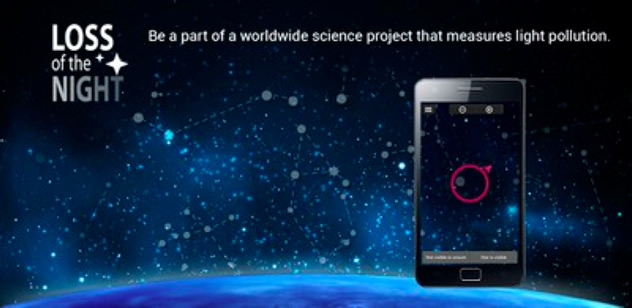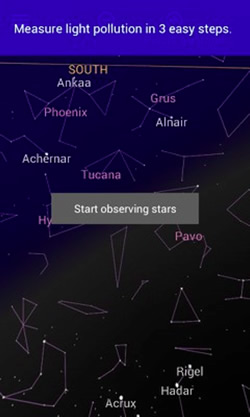

Are you concerned about light pollution? Would you like to do something to help? Then you might want to take advantage of the new, free app developed for Android smartphones. Created by researchers for the German "Loss of Night" project, the new app can count the number of visible stars in the sky. Citizen science? You bet. The results will be used by scientists to help understand light pollution on a global scale.
"In natural areas you can see several thousand stars with the naked eye" says Dr. Christopher Kyba, physicist at the Leibniz-Institute of Freshwater Ecology and Inland Fisheries (IGB) and Freie Universitšt. "In Berlin, we can still see several hundred, but the situation in most large cities and world capitals is far worse."
What does it do? The smartphone app will calculate skyglow and assist the current citizen science project "GLOBE at Night" in its study of the impact of light pollution. The data it collects can then be translated into maps which show the distribution and changes in sky brightness. Information of this type will help researchers determine impacts on health, biodiversity, energy waste, and far more.
It's easy to use. The app prompts users to identify certain individual stars and whether or not they are visible. By determining the faintest star, researchers can then surmise how many stars can be seen at that location and reasonably determine how bright the sky is.

Illustrations Courtesy of Cosalux GmbH
"Life evolved from periodic changes of bright days and dark nights," says Dr. Annette Krop-Benesch of the Leibniz-Institute of Freshwater Ecology and Inland Fisheries (IGB). "The introduction of artificial light into the atmosphere is changing ecosystems worldwide, and might even have an impact on our health. Unfortunately, we have very little information about light levels in different habitats at night."
"With this app, people from around the world can collect data on skyglow without needing expensive equipment," says Fabian Kohler from The German Ministry of Education and Research (BMBF).
The app also allows users to compare the sky brightness at their home to other locations. This function had surprising results as some testers inadvertently learned the names of several stars and constellations. It was developed in partnership with the firm Cosalux (Offenbach am Main), and is based on the widely used Google Sky Map application. The development of the app was sponsored by the German Federal Ministry of Research and Education, as part of Science Year 2012: "Project Earth: Our Future".
Use of technology such as this is very important for many reasons. Right now, satellites which observe Earth's night sky can only measure the light radiated into the sky itself?not the brightness experienced terrestrially. This information can be used to create models which estimate skyglow, but the models need to be tested, and the new app will be able to help.
Need more reasons to use the new app? Then know that satellite observatories aren't sensitive to certain wavelengths?meaning areas lit by white LED light appear darker than they really are. Do your part to help! The app "Loss of the Night" can be downloaded in English and German HERE. It is free of charge and another triumph for citizen science!
Tammy Plotner is a professional astronomy author, President Emeritus of Warren Rupp Observatory and retired Astronomical League Executive Secretary. She's received a vast number of astronomy achievement and observing awards, including the Great Lakes Astronomy Achievement Award, RG Wright Service Award and the first woman astronomer to achieve Comet Hunter's Gold Status.
Original Story Source: Berlin Institute News Release















